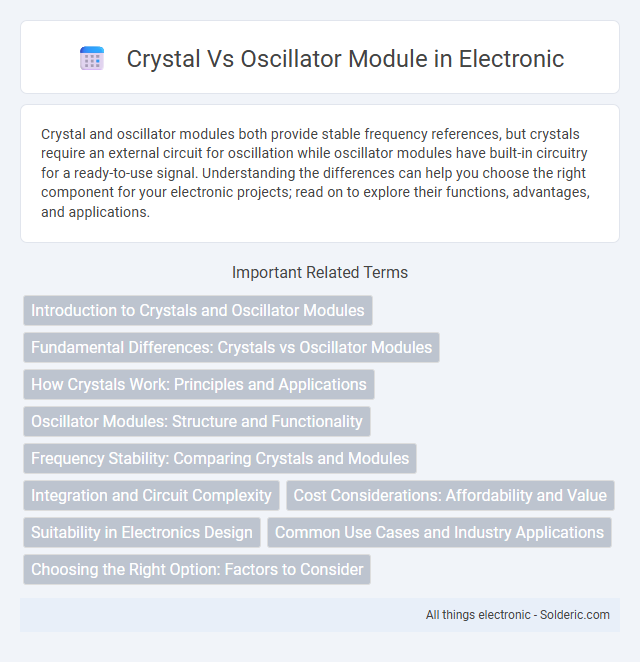Crystal and oscillator modules both provide stable frequency references, but crystals require an external circuit for oscillation while oscillator modules have built-in circuitry for a ready-to-use signal. Understanding the differences can help you choose the right component for your electronic projects; read on to explore their functions, advantages, and applications.
Comparison Table
| Feature | Crystal | Oscillator Module |
|---|---|---|
| Function | Resonant frequency element | Complete clock source with built-in oscillator circuit |
| Output Signal | Mechanical resonance, requires external circuit | Stable digital clock signal |
| Frequency Stability | High, but affected by temperature & load | Higher stability due to integrated circuitry |
| Ease of Use | Needs external driver circuit | Plug and play, no additional circuitry needed |
| Cost | Lower cost | Higher cost |
| Size | Smaller footprint | Typically larger due to housing and components |
| Applications | Microcontrollers, watches, radios requiring timing elements | Advanced timing control, RF circuits, complex systems |
Introduction to Crystals and Oscillator Modules
Crystals provide highly stable frequency references by utilizing the piezoelectric properties of quartz to generate consistent oscillations. Oscillator modules integrate these crystals with active circuitry, delivering ready-to-use clock signals with enhanced accuracy and reduced noise for electronic devices. Your choice between a standalone crystal and an oscillator module impacts the precision and complexity of your system's timing performance.
Fundamental Differences: Crystals vs Oscillator Modules
Crystals function as passive frequency-selective components that require external circuitry to generate oscillations, while oscillator modules integrate the crystal with active circuitry to provide a complete, stable output signal. The fundamental difference lies in the complexity and convenience; crystals offer lower cost and flexibility but need additional components and design effort, whereas oscillator modules deliver ready-to-use frequency signals with improved stability and ease of integration. Your choice depends on whether you prioritize design control with crystals or streamlined implementation using oscillator modules.
How Crystals Work: Principles and Applications
Crystals operate based on the piezoelectric effect, where applying an electrical signal causes the quartz crystal to vibrate at a precise frequency, providing stable oscillations crucial for timing applications. These vibrations generate consistent frequency signals used in watches, radios, and microcontrollers for accurate timekeeping and signal processing. Crystal oscillators leverage this principle in electronic circuits to ensure frequency stability and low phase noise, essential for communication systems and digital devices.
Oscillator Modules: Structure and Functionality
Oscillator modules integrate a crystal, amplifier, and additional circuitry in a compact package, providing a stable and accurate frequency source for electronic devices. Unlike standalone crystals, these modules generate a complete oscillating signal, simplifying design and improving signal integrity in applications such as communication systems and microcontroller clocks. Your projects benefit from oscillator modules' enhanced temperature stability and reduced electromagnetic interference compared to discrete crystal arrangements.
Frequency Stability: Comparing Crystals and Modules
Crystals offer exceptional frequency stability due to their precise quartz resonator, typically achieving stability within +-10 to +-50 ppm over temperature variations. Oscillator modules incorporate crystals alongside integrated circuits that enhance frequency stability further, often reaching +-1 to +-10 ppm by compensating for temperature and aging effects. Selecting oscillator modules over standalone crystals improves overall frequency precision in demanding applications such as communication systems and precision timing.
Integration and Circuit Complexity
Crystal modules typically offer simpler integration due to their standalone design, requiring fewer external components and less PCB space, which reduces overall circuit complexity. Oscillator modules, while more integrated with built-in amplifier and feedback network, often demand careful power supply decoupling and signal conditioning to ensure optimal performance, potentially increasing design intricacy. The choice between crystal and oscillator modules directly impacts the design workflow, with crystals favoring basic oscillator circuits and oscillator modules providing an all-in-one frequency source.
Cost Considerations: Affordability and Value
Crystal modules generally offer lower cost and greater affordability for basic timing needs, making them ideal for budget-conscious projects. Oscillator modules, while more expensive, provide enhanced stability and integrated circuitry, delivering better overall value for applications requiring precision. Your choice depends on balancing initial expense with long-term performance benefits for the specific use case.
Suitability in Electronics Design
Crystal modules provide precise frequency stability, making them ideal for timing applications such as microcontrollers and communication devices where accuracy is critical. Oscillator modules integrate additional circuitry for signal conditioning, offering ease of use and flexibility in applications requiring varied frequency outputs and faster startup times. Choosing the right component depends on your project's need for precision, integration, and power consumption characteristics.
Common Use Cases and Industry Applications
Crystal modules are commonly used in consumer electronics, such as smartphones and wearable devices, due to their stability and low power consumption. Oscillator modules find extensive application in telecommunications and industrial automation where precise frequency control and signal generation are critical. Your choice between the two should consider the device's performance requirements and environmental conditions to ensure optimal functionality.
Choosing the Right Option: Factors to Consider
Choosing between a crystal and an oscillator module depends on factors like frequency stability, power consumption, and integration complexity. Crystals offer high precision and low phase noise but require external circuitry, while oscillator modules provide a compact, ready-to-use solution with built-in oscillation circuitry. Your decision should be guided by application requirements, size constraints, and budget to ensure optimal performance and reliability.
Crystal vs Oscillator Module Infographic

 solderic.com
solderic.com